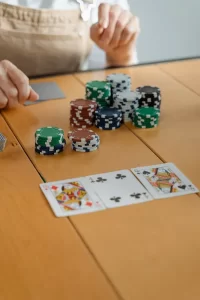“Unlocking Potentials: Advanced Techniques for Exploiting Weaknesses in Poker Cash Games” is a comprehensive guide that delves into advanced strategies and techniques for capitalizing on weaknesses in poker cash games. This book aims to provide players with the knowledge and skills necessary to identify and exploit the vulnerabilities of their opponents, ultimately enhancing their own profitability and success in cash game poker.
Identifying and Exploiting Common Poker Weaknesses in Cash Games
One common weakness that many players exhibit is a lack of aggression. Some players are too passive, often checking or calling instead of betting or raising. This can be a golden opportunity for you to exploit their weakness. By being aggressive and betting or raising frequently, you can put pressure on these players and force them to make difficult decisions. This strategy works particularly well against tight players who are afraid to take risks. By exploiting their fear, you can win pots without even having the best hand.
Another common weakness is a tendency to play too many hands. Some players simply cannot resist the urge to see a flop, even with weak starting hands. This is where you can exploit their weakness by playing tight and only entering pots with strong hands. By doing so, you increase your chances of winning when you do get involved in a hand, while also avoiding unnecessary losses. Additionally, by playing tight, you can often steal pots from these loose players by betting aggressively when they show weakness.
One weakness that is often overlooked is a lack of position awareness. Many players fail to recognize the importance of their position at the table and how it affects their decision-making. By exploiting this weakness, you can gain a significant edge. For example, when you are in late position, you have the advantage of seeing how your opponents act before you make your decision. This allows you to make more informed choices and potentially bluff or steal pots when your opponents show weakness. Conversely, when you are in early position, you should be more cautious and only play strong hands, as you will have to act first throughout the hand.
A weakness that is prevalent among inexperienced players is a lack of understanding of pot odds and implied odds. These players often make incorrect calls or bets based on their gut feelings rather than logical calculations. By exploiting this weakness, you can make profitable decisions based on the mathematics of the game. For example, if you have a drawing hand and the pot odds are in your favor, you can make a call or a bet knowing that, in the long run, it will be a profitable move. This can lead to significant gains over time, as your opponents continue to make incorrect decisions based on their lack of understanding.
In conclusion, identifying and exploiting weaknesses in poker cash games can give you a significant advantage over your opponents. By being aggressive, playing tight, understanding position, and utilizing pot odds, you can unlock the potentials of exploiting common weaknesses. However, it is important to remember that poker is a dynamic game, and your opponents may adjust their gameplay once they realize their weaknesses are being exploited. Therefore, it is crucial to stay adaptable and continue to analyze your opponents’ gameplay throughout the game. With practice and experience, you can become a master at exploiting weaknesses and maximizing your profits in poker cash games.
Advanced Strategies for Exploiting Bluffing Tendencies in Poker Cash Games
To exploit bluffing tendencies, you must first identify the players who are prone to bluffing. These players are often aggressive and tend to bet or raise frequently, even when they have weak hands. They rely on their ability to intimidate their opponents and force them to fold. By recognizing these players, you can adjust your strategy accordingly and take advantage of their aggressive tendencies.
One technique for exploiting bluffing tendencies is to call down your opponents more often. When facing a suspected bluffer, it can be tempting to fold when you have a marginal hand. However, by calling down more frequently, you force your opponent to show their hand and reveal whether they were bluffing or not. This information can be invaluable in future hands, as it allows you to make more informed decisions based on your opponents’ tendencies.
Another strategy for exploiting bluffing tendencies is to make well-timed raises. When you suspect that your opponent is bluffing, a well-timed raise can put them in a difficult spot. If they were bluffing, they will likely fold to your raise, allowing you to win the pot without a showdown. Even if they call your raise, you still have the opportunity to outplay them on later streets and potentially win a larger pot.
It’s important to note that exploiting bluffing tendencies requires careful observation and analysis. You must pay close attention to your opponents’ betting patterns and hand ranges to determine when they are bluffing. This requires a keen eye for detail and the ability to make accurate reads on your opponents.
In addition to calling down and making well-timed raises, another technique for exploiting bluffing tendencies is to use the check-raise. The check-raise is a powerful move that can put your opponents in a tough spot. When you suspect that your opponent is bluffing, you can check to them and then raise their bet. This puts pressure on them to either fold or call a larger bet, potentially forcing them to make a costly mistake.
However, it’s important to use the check-raise sparingly and selectively. If you overuse this move, your opponents will catch on and adjust their strategy accordingly. It’s crucial to mix up your play and keep your opponents guessing. By doing so, you maintain your edge and prevent your opponents from exploiting your own tendencies.
In conclusion, exploiting bluffing tendencies is a crucial skill in poker cash games. By identifying players who are prone to bluffing and adjusting your strategy accordingly, you can maximize your profits and gain a significant edge at the table. Techniques such as calling down, making well-timed raises, and using the check-raise can be highly effective in exploiting bluffing tendencies. However, it’s important to approach these strategies with caution and use them selectively to maintain your edge. With practice and experience, you can unlock the full potential of exploiting bluffing tendencies and become a formidable force at the poker table.
Maximizing Profits by Exploiting Passive Players in Poker Cash Games
Passive players, also known as calling stations, are those who tend to call bets rather than raise or fold. They are often risk-averse and prefer to see more cards before committing their chips. While this style of play may seem safe, it can be a goldmine for astute players who know how to exploit it.
One effective technique for exploiting passive players is to value bet aggressively. Since these players are more likely to call bets, even with weaker hands, it is crucial to extract maximum value from them. By betting larger amounts when holding strong hands, you force them to make difficult decisions. They may feel compelled to call, even when they suspect they are behind, leading to increased profits for you.
Another strategy is to bluff selectively against passive players. While they are more inclined to call, they are also less likely to make aggressive moves themselves. By bluffing in spots where they are likely to fold, you can steal pots that would otherwise be contested. However, it is important to choose your spots wisely and avoid bluffing excessively, as passive players are more likely to call down with marginal hands.
Positional advantage is a crucial factor when exploiting passive players. Being in late position allows you to see their actions before making your own decisions. This information advantage enables you to adjust your betting sizes and ranges accordingly. For example, if a passive player has called multiple bets before you, you can increase your bet size with a wider range of hands, knowing that they are likely to call.
Furthermore, exploiting passive players requires a keen understanding of their tendencies. Observing their patterns of play can provide valuable insights into their hand ranges and decision-making processes. For instance, if a passive player consistently calls bets on the flop and turn but folds on the river, you can exploit this by bluffing on the river more frequently.
It is also important to be aware of your own table image when exploiting passive players. If you have been playing tight and only showing down strong hands, they are more likely to give you credit for having a strong hand when you bet. This can allow you to bluff more effectively and extract larger pots when you do have a strong hand.
Lastly, it is crucial to remain adaptable and adjust your strategies as the game evolves. Passive players may become more aggressive if they sense that they are being exploited. In such cases, it may be necessary to tighten up your range and focus on value betting rather than bluffing.
In conclusion, exploiting passive players in poker cash games is a skill that can significantly increase your profits. By value betting aggressively, bluffing selectively, leveraging positional advantage, understanding their tendencies, managing your table image, and remaining adaptable, you can unlock the potential of these players and maximize your winnings. Remember, poker is a game of strategy, and those who can exploit weaknesses are the ones who come out on top.
Exploiting Positional Weaknesses in Poker Cash Games for Strategic Advantage
Positional weaknesses refer to the disadvantage that a player faces when they are forced to act before their opponents. In poker, the player who acts last has a significant advantage, as they have more information about their opponents’ actions and can make more informed decisions. Exploiting positional weaknesses involves using this advantage to manipulate the actions of other players and gain an edge in the game.
One technique for exploiting positional weaknesses is known as “stealing the blinds.” The blinds are forced bets that two players must make before the cards are dealt. The player in the small blind position is at a positional disadvantage, as they must act first after the flop. By raising the bet from the late position, a player can put pressure on the small blind and force them to fold, thus winning the blinds without having to show their cards.
Another technique for exploiting positional weaknesses is called “isolation.” This strategy involves targeting a weak player who is in an early position and raising the bet to isolate them. By doing so, the player can force the other players to fold, leaving them alone with the weak opponent. This increases their chances of winning the pot, as they can use their positional advantage to make more informed decisions and exploit the weaknesses of the isolated player.
Positional weaknesses can also be exploited through the use of “squeeze plays.” A squeeze play occurs when a player in a late position raises the bet after one or more players have already called or raised. This puts pressure on the players who have already invested chips in the pot, forcing them to make a difficult decision. By using this strategy, a player can exploit the positional weaknesses of their opponents and potentially win the pot without having the best hand.
In addition to these techniques, players can also exploit positional weaknesses by carefully observing their opponents’ actions and tendencies. By paying attention to how players in different positions play their hands, a player can gain valuable information about their opponents’ strategies and adjust their own accordingly. For example, if a player notices that a particular opponent often folds when faced with a raise from a late position, they can exploit this weakness by raising more frequently from that position.
Exploiting positional weaknesses in poker cash games requires a combination of skill, strategy, and observation. It is not enough to simply understand the concept of positional advantage; players must also be able to read their opponents and make informed decisions based on the information they gather. By mastering these advanced techniques, players can unlock their full potential and gain a significant edge in the world of poker cash games. So, the next time you sit down at the poker table, remember to keep an eye out for positional weaknesses and use them to your advantage.
Unleashing Your Potential: Advanced Techniques for Exploiting Poker Weaknesses in Cash Games
Unlocking Potentials: Advanced Techniques for Exploiting Weaknesses in Poker Cash Games
One of the most effective ways to exploit weaknesses in cash games is by studying your opponents’ playing styles. Every player has their own unique approach to the game, and by observing their tendencies, you can gain valuable insights into their strategies. Are they aggressive or passive? Do they bluff frequently or play tight? By answering these questions, you can adjust your own strategy accordingly and exploit their weaknesses.
Another technique for exploiting weaknesses is by targeting players who are on tilt. Tilt is a state of emotional frustration or anger that can cause players to make irrational decisions. When a player is on tilt, they are more likely to make mistakes and play poorly. By identifying these players and applying pressure, you can take advantage of their emotional state and increase your chances of winning.
Position is another crucial factor in exploiting weaknesses in cash games. The later you act in a hand, the more information you have about your opponents’ actions. This allows you to make more informed decisions and exploit their weaknesses more effectively. By playing aggressively in late position, you can put pressure on your opponents and force them to make difficult decisions.
Exploiting weaknesses in cash games also requires a deep understanding of hand ranges. A hand range is the range of hands that a player can have based on their actions and the community cards. By narrowing down your opponents’ hand ranges, you can make more accurate decisions and exploit their weaknesses. For example, if you know that a player only raises with premium hands, you can fold weaker hands and avoid unnecessary losses.
Bluffing is another advanced technique that can be used to exploit weaknesses in cash games. By bluffing strategically, you can force your opponents to fold stronger hands and win pots that you would otherwise lose. However, bluffing should be used sparingly and with caution. It requires a thorough understanding of your opponents’ tendencies and the ability to read their reactions. Bluffing without a solid plan can backfire and lead to significant losses.
Lastly, exploiting weaknesses in cash games requires discipline and patience. It is important to stay focused and avoid making impulsive decisions. By carefully observing your opponents and waiting for the right opportunities, you can maximize your chances of success. Remember, poker is a long-term game, and exploiting weaknesses is a gradual process that requires persistence and dedication.
In conclusion, exploiting weaknesses in poker cash games is a skill that can be developed with practice and experience. By studying your opponents’ playing styles, targeting players on tilt, utilizing position, understanding hand ranges, bluffing strategically, and maintaining discipline, you can unlock your potential and increase your chances of success. Remember, poker is a game of skill, and by exploiting weaknesses, you can gain a significant edge over your opponents. So, go out there, unleash your potential, and dominate the cash game tables! Unlocking potentials in poker cash games involves advanced techniques for exploiting weaknesses. By identifying and capitalizing on opponents’ vulnerabilities, players can gain a significant advantage and increase their chances of winning. These techniques include studying opponents’ playing styles, analyzing their betting patterns, and adapting one’s own strategy accordingly. Additionally, understanding the concept of pot odds and utilizing effective bluffing strategies can further enhance a player’s ability to exploit weaknesses in cash games. Overall, unlocking potentials in poker cash games requires a combination of skill, strategy, and adaptability to maximize one’s success at the table.




